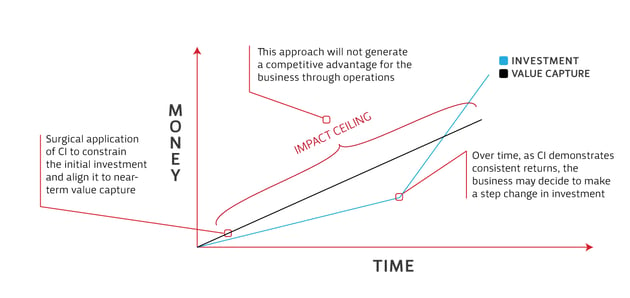In Part 1 of this series, I described the Brute Force Model as one approach to deploying continuous improvement. Part 2 will address a second common CI deployment model that effectively mitigates some of the risks and challenges of the Brute Force Model, but comes with its own caveats.
Option 2: The Incremental Model
If the Brute Force Model is characterized by a substantial early stage investment in CI that requires impeccable execution to minimize ROI lag, the Incremental Model is, in many ways, the opposite approach. A critical objective behind this model is to actively manage the organization’s investment in CI in order to generate positive returns and prove the concept without taking on too much risk. In many cases the Operations Leader is hoping to build internal momentum for a more substantial investment in CI by racking up a series of validated success stories.
The Incremental Model typically involves hiring a corporate CI Leader and perhaps select few additional CI resources to support him/her (or, alternatively, retaining a boutique external consultant willing to operate within clearly defined budget constraints). This CI Leader, working with a modest budget, is tasked to identify (if not already known) some operational challenges that can be addressed through one or more focused CI projects. Ideally, there may be a manufacturing site or two with leadership that is friendly to CI and is willing to support the CI Leader in this effort. As the projects are implemented, and assuming they are successful, the success stories are communicated across the organization in order create “pull” for CI and justify additional investment. Unlike the Brute Force Model, because the investment in CI is constrained, if there happen to be a few “hiccups” in the process, nobody in the organization gets too bent out of shape…it gets chalked up as a learning experience and all part of the larger CI “journey.” Quick aside…the term “journey” in relation to CI is often woefully misused. A journey is something that persons commits to do for the expressed purpose of reaching a destination (otherwise, it’s not a journey but merely aimless wandering). The organization is not on a CI journey if it’s not committed to it and hasn’t clearly defined what success looks like.
Now back to the topic at hand, what’s important to understand is that, while the Incremental Model effectively mitigates the primary risks and challenges associate with the Brute Force Model, it stands little chance of ever generating enough value to create a sustainable competitive advantage for the business. In other words, the companies who have succeeded in moving their businesses up the performance curve through CI haven’t done so through a safe, incremental approach. In fact, it’s quite the opposite. The companies that are known to have created a sustainable competitive advantage through CI are the ones who are truly committed to it from top to bottom and reflect that commitment through their investment. Long story made short, this model might represent the path of least resistance and may even make you feel good about the fact that your organization is “doing CI,” but it won’t impact your business in a substantive way.
There’s a second risk with the Incremental Deployment Model, one that often gets overlooked until it becomes obvious that something’s not working. Namely, the level of investment in CI is likely a reflection, at least in the minds of some workers, of its relative importance and potential “staying power.” With the Brute Force Model, the organization risks getting resistance from the workforce due to the potentially disruptive nature of the deployment (this risk was discussed in greater detail in Part 1). With the Incremental Model, large scale resistance may not be as big a concern, but the organization may find out that CI is getting marginalized because the workforce believes it to be optional instead of essential (i.e., “We’ll get around to doing CI when it doesn’t interfere with the day-to-day priorities of the site.”).
The chart below visualizes how the Incremental Model typically works. What’s key to consider is whether this deployment approach will ever generate transformational results for the organization and, if not, is there an alternative deployment model that can generate those results without taking on all of the investment risk associated with the Brute Force Model. We’ll consider that exact issue in Part 3 of this series.

Phase 5 Group and EON
At Phase 5 Group, we’ve partnered with leading companies to drive a structured and disciplined approach to their CI journey to ensure business impact and sustainability. The experience gained over a period of years is what led us to develop EON. EON helps companies that are committed to a systemic approach to continuous improvement to set and manage strategy, execute improvement projects, implement best practices, and calculate their operational gap to perfect. Our leading indicators scorecard provides unparalleled business intelligence in the form of activity- and outcome-based metrics to help our clients to better manage their continuous improvement implementations.
Please contact us to learn more about EON, the world’s first comprehensive continuous improvement management platform.

